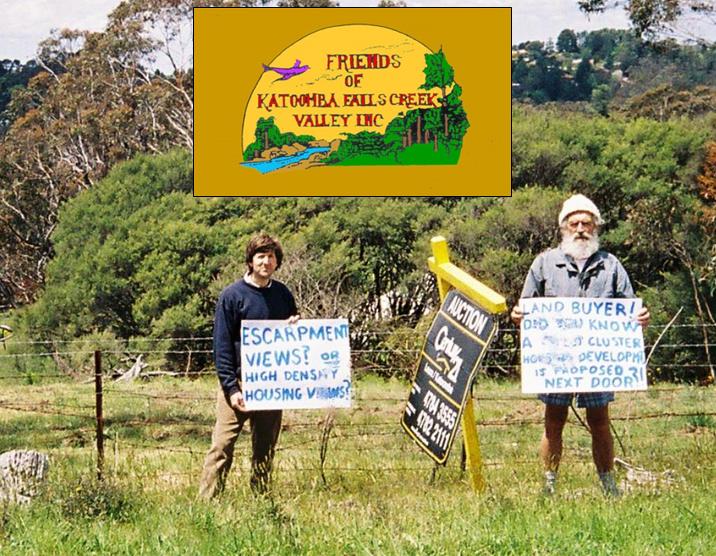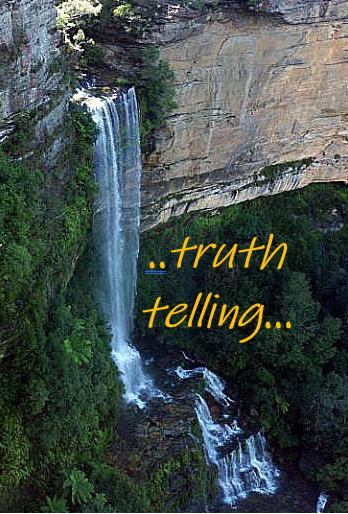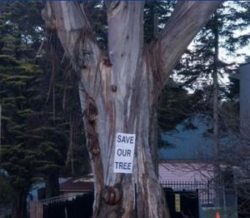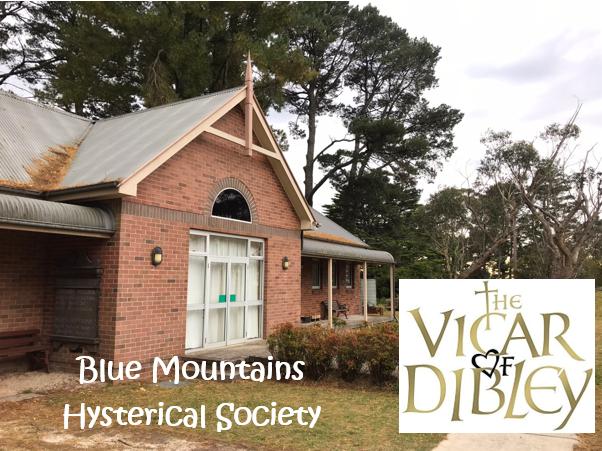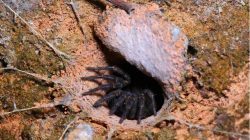Author Archive
Monday, June 13th, 2011
Radical Australian wildlife activist ‘Tigerquoll‘ from the popular socio-political website ‘CanDoBetter.net‘ is set to join The Habitat Advocate.
Tigerquoll, over recent years, has established a forthright and controversial online blog presence at CanDoBetter.net
Victorian-based Tigerquoll, from Suggan Buggan in Snowy River Region of Australia, says he can offer us a more southern and ‘colder’ perspective on Australian wildlife issues and threats.
Tigerquoll has expressed that he remains an angry young man resentful of those who harm wildlife and of government agencies who falsely proclaim their role of wildlife conservation and protection.
He admits a dogged resolve and a lack of diplomacy.
He feels he often attracts aggression yet feels he is misunderstood since his intentions are honorable to those he seeks to protect
Check out: Tigerquoll’s Blog
We at The Habitat Advocate welcome our new contributor and what is set to become a more activist tone for our cause for maximising wildlife respect and conservation.
Watch this space!
~ Editor
Friday, June 10th, 2011
One by one, roadside vegetation, roadside communities, and villages through the Blue Mountains are capitulating to the New South Wales Government’s agency, the Roads and Traffic Authority (RTA). One diesel-driven programme to convert a regional highway into a dangerously fast heavy trucking expressway.
The RTA is an ‘authority’ alright – a testament to when absolute authority is allowed to overrule local values at any cost.
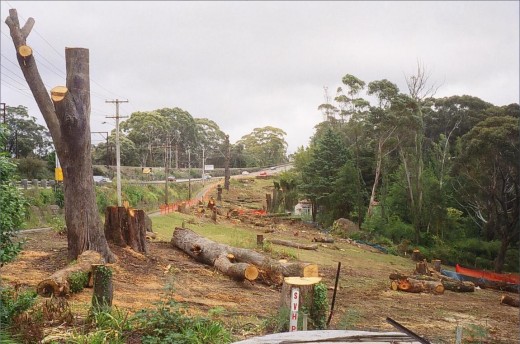 Leura, Blue Mountains, Australia, 22nd Dec 2006)
(click photo to enlarge) Leura, Blue Mountains, Australia, 22nd Dec 2006)
(click photo to enlarge)
.
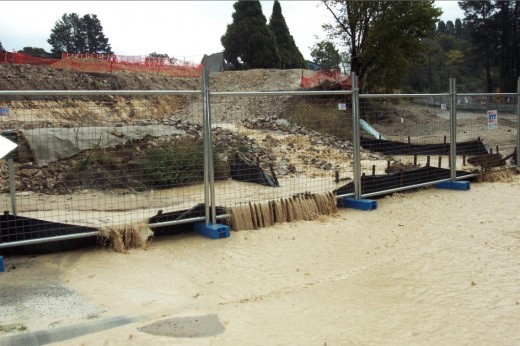 RTA rainfall retention gross failure, Leura 30th June 2005
(click photo to enlarge) RTA rainfall retention gross failure, Leura 30th June 2005
(click photo to enlarge)
.
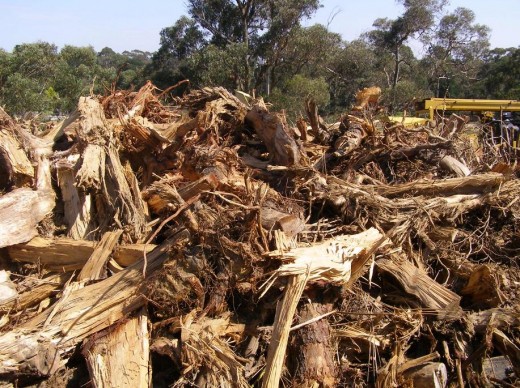 Trees hacked to make way for the RTA expressway, 4th February 2007
(click photo to enlarge) Trees hacked to make way for the RTA expressway, 4th February 2007
(click photo to enlarge)
.
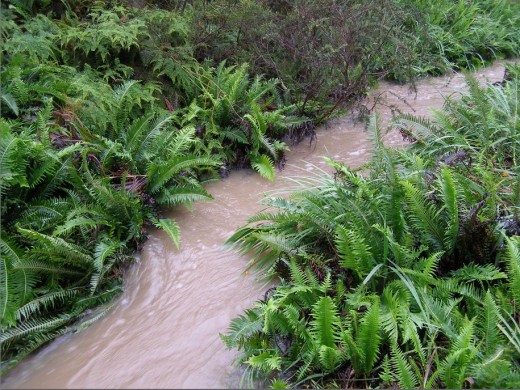 RTA construction sediment down the drain and into Blue Mountains World Heritage creeks, 16th January 2006
(click photo to enlarge) RTA construction sediment down the drain and into Blue Mountains World Heritage creeks, 16th January 2006
(click photo to enlarge)
Thursday, June 9th, 2011
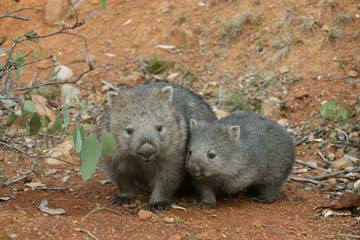
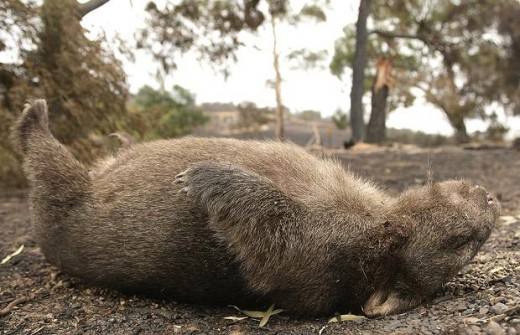
.
A poem…
.
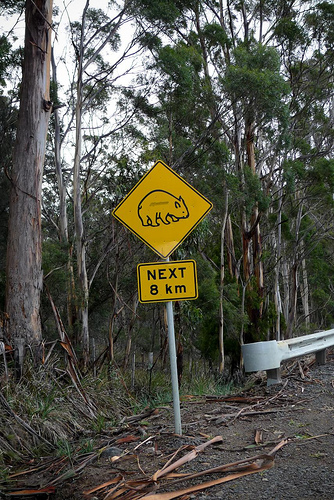
Evil upheaval
Another dead wombat, roadside
always inverted
confirming horrific death
by morning – motionless, cold, dead
gone
.
A mother ripped from her family
a life gone
dependant lives cast into upheaval
she’s not coming back
empty nights, waiting, searching
.
Someone’s roadkill
no mourning
no roadside memorial
just Nature’s maggots
.
A family’s world gone
lost to night driving,
lost to special places where wombats once roamed free, content and without fear.
.
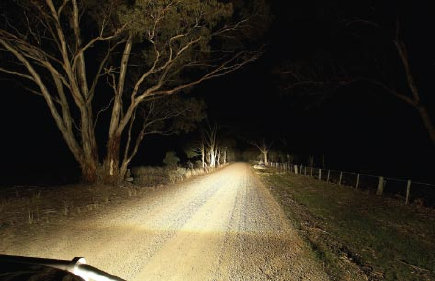
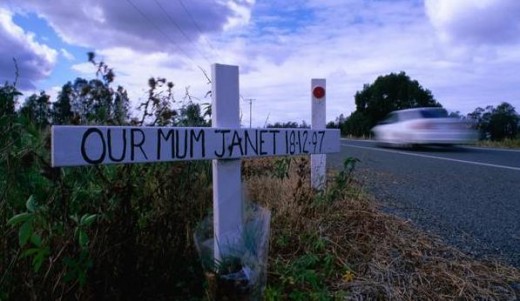
.
~ Editor’s reflections from last Monday morning (6th June 2011) observed along the roadside on the way in to Mittagong; now permanently implanted in memory.
Wednesday, June 8th, 2011
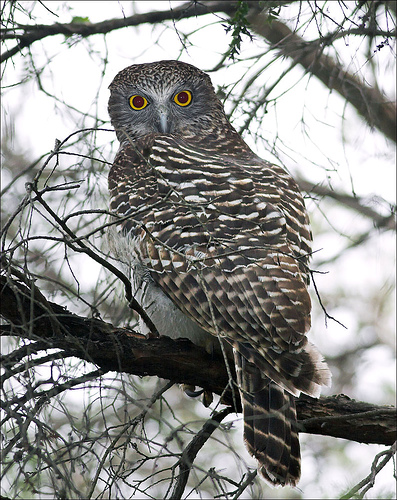 Australia’s Powerful Owl (Ninox strenua) Australia’s Powerful Owl (Ninox strenua)
.
Like many native species in Australia, the Powerful Owl’s conservation status is deemed to be ‘Vulnerable’.
It remains the largest owl in Australasia, endemic to eastern and south-eastern Australia (that is it lives naturally nowhere else on the planet).
Now uncommon throughout its range where it occurs at low densities preferring woodland and open sclerophyll forest to tall open wet forest and rainforest.
The Powerful Owl requires large tracts of forest or woodland habitat but can occur in fragmented landscapes as well. The species breeds and hunts in open or closed sclerophyll forest or woodlands and occasionally hunts in open habitats. It roosts by day in dense vegetation comprising species such as Turpentine Syncarpia glomulifera, Black She-oak Allocasuarina littoralis, Blackwood Acacia melanoxylon, Rough-barked Apple Angorphora floribunda, Cherry Ballart Exocarpus cupressiformis and a number of eucalypt species.
.
The main prey items are medium-sized arboreal marsupials, particularly the Greater Glider, Common Ringtail Possum and Sugar Glider. There may be marked regional differences in the prey taken by Powerful Owls. For example in southern NSW, Ringtail Possum make up the bulk of prey in the lowland or coastal habitat. At higher elevations, such as the tableland forests, the Greater Glider may constitute almost all of the prey for a pair of Powerful Owls. Birds comprise about 10% of the diet, with flying foxes important in some areas. As most prey species require hollows and a shrub layer, these are important habitat components for the owl.
.
Pairs of Powerful Owls are believed to have high fidelity to a small number of hollow-bearing nest trees and will defend a large home range of 400-1450 ha.
Powerful Owls nest in large tree hollows (at least 0.5 m deep), in large eucalypts (diameter at breast height of 80-240 cm) that are at least 150 years old. During the breeding season, the male Powerful Owl roosts in a “grove” of up to 20-30 trees, situated within 100-200 metres of the nest tree where the female shelters.
.
Unlike many humans, Powerful Owls are monogamous and mate for life, making them a superior species.
.
Human Threats to Powerful Owls
...
Powerful Owls have for decades been threatened by the human caused ongoing loss and fragmentation of habitat. Important forest and woodland habitat continues to be cleared and burned for reasons justifying human residential and agricultural development. This loss also affects the populations of arboreal prey species, particularly the Greater Glider which reduces food availability for the Powerful Owl.
Inappropriate forest harvesting practices that have changed forest structure and removed old growth hollow-bearing trees.
Loss of hollow-bearing trees reduces the availability of suitable nest sites and prey habitat. Can be extremely sensitive to disturbance around the nest site, particularly during pre-laying, laying and downy chick stages. Disturbance during the breeding period may affect breeding success.
High frequency hazard reduction burning is also reduce the longevity of individuals by affecting prey availability.
[Source: NSW Department of Environment, http://www.threatenedspecies.environment.nsw.gov.au/tsprofile/profile.aspx?id=10562]
.
In 2007, the New South Wales Labor Government in its State Transit department was found to have poisoned many powerful owls and other wild birds around Ryde in its so-called pest control plan.
.
‘The government-owned agency employed a poison expert to kill pest Indian mynah birds at their bus depot in Ryde but local residents watched in horror as kookaburras, galahs, magpies and rosellas started falling out of the sky.’
‘A spokeswoman said the last poisoning campaign, using baited bird seed, was on November 12.’
[Source: ‘Bird-brained system killing wildlife’, The Daily Telegraph, 14th December 2007, http://www.dailytelegraph.com.au/news/sydney-nsw/bird-brained-system-killing-wildlife/story-e6freuzi-1111115108124 ]

Saturday, June 4th, 2011
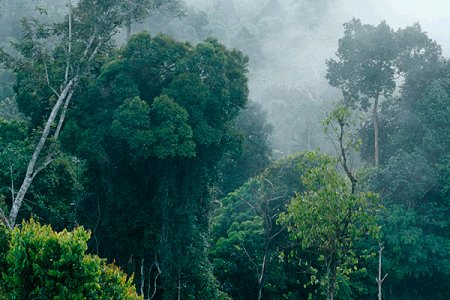
In Indonesia, bulldozing rainforest for profitable palm oil plantations for western diets has become highly profitable due to western corporate demand…


In Indonesia’s Borneo (Kalimantan) the rainforest habitat of orangutans is being destroyed, largely to make way for palm oil plantations due to western diet demand
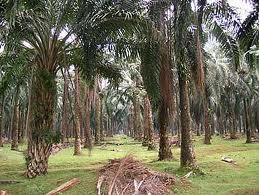
Arnott’s relies up on palm oil in its popular western ‘Tim Tam’ biscuit product
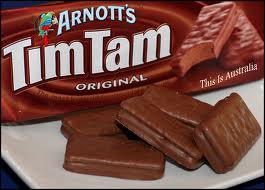
Just like these other western brands do:

The palm oil driven rainforest deforestation in Borneo (Kalimantan) thanks to unethical palm oil demand from the likes of Arnott’s…
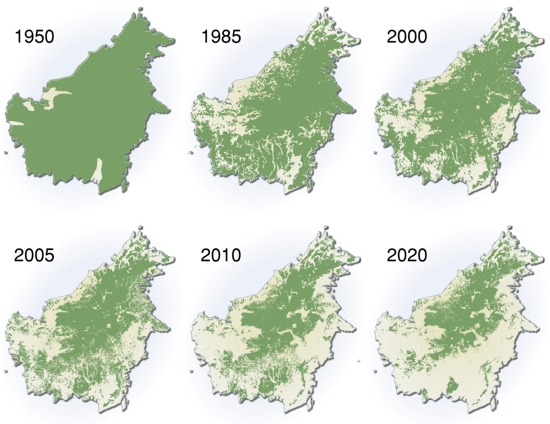
Try finding a shrinking rainforest map on the wrapper of a packet of Tim Tams!
Indonesian unethical destruction of orangutan rainforest habitat continues to provide for palm oil plantations.
This is costing the lives of about 50 orangutans every week.
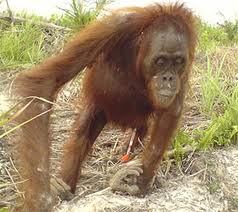
Arnott’s knows this, yet continues to buy the palm oil and drive the Indonesian palm oil deforestation.
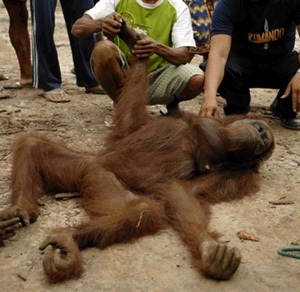
Arnott’s is expanding its sales of palm oil Tim Tams with new product offerings:

2011 has been declared by the United Nations as the International Year of Forests.
Arnott’s knows this.
 It won’t be long before human demand for Tim Tams and other palm oil consumer products have driven the orangutan into extinction. It won’t be long before human demand for Tim Tams and other palm oil consumer products have driven the orangutan into extinction.
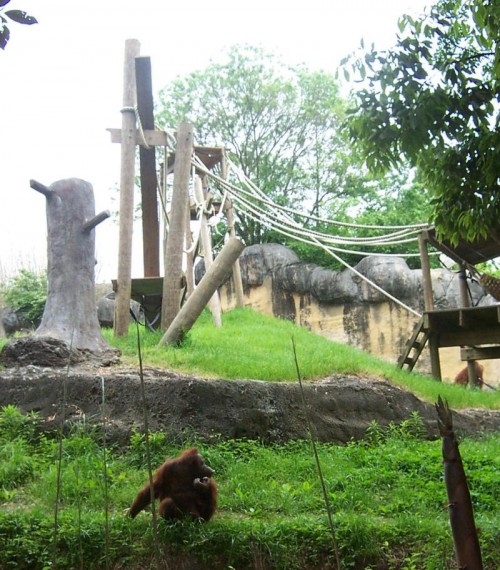
Tim Tams have become the western addiction driving orangutan extinction.
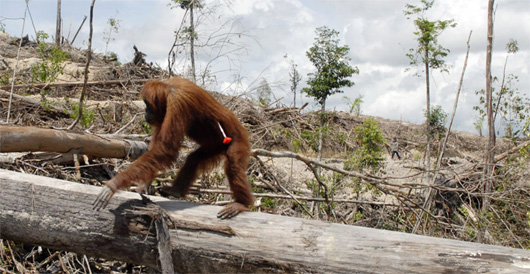
Arnott’s chocolate biscuits are more than a weight gaining guilt.
You eat them, you kill a species.


Will someone make clear to the Arnott’s Board that for Orangutans THERE IS NO SUBSTITUTE FOR QUALITY HABITAT.
Tags: arnott's, Borneo, fragile forest ecosystems, Kalimantan, no substitute for quality habitat, orangutan, palm oil plantations, pringle orphans, rainforests, tim tam, tim tam orphans, UN International Year of Forests, World Environment Day 5th June
Posted in Kalimantan (ID), Orang-utans, Threats from Deforestation, Threats from Farming | No Comments »
Add this post to Del.icio.us - Digg
Thursday, June 2nd, 2011
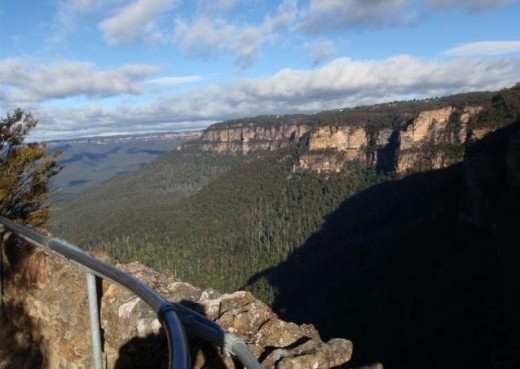 Jamison Valley from Sublime Point, Leura
(Blue Mountains, New South Wales, Australia) Jamison Valley from Sublime Point, Leura
(Blue Mountains, New South Wales, Australia)
.
For those who have purchased an escarpment-edge bush block in Blue Mountains villages of Leura, Wentworth Falls or Katoomba, who have ‘arranged‘ for native escarpment habitat to be killed in order to gain property views to the magnificent Jamison Valley, such actions are selfish and contribute to the ecological vandalism and disappearance of important and scarce escarpment habitat.
For others enjoying the Jamison Valley naturally on foot, to look back up at the Leura escarpment has become an ugly one dominated by increasing housing development.
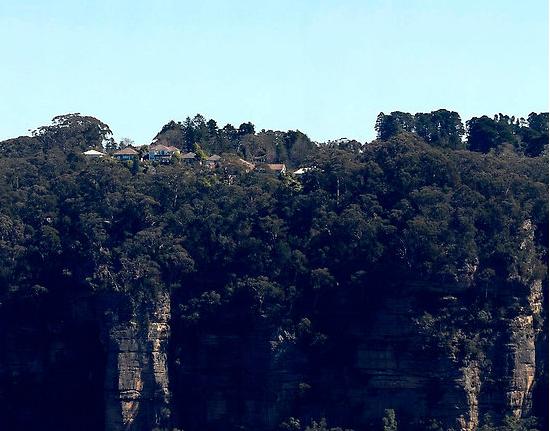
Views are bidirectional, but try explaining that to a property developer or to those real estate agents who only appreciate the sales commission.
On the spectacular escarpment fringe of the much valued village of Leura in the much valued Blue Mountains, not only have the fire-lighters taken a fancy at setting fire to nearby prized escarpment bushland, but the property developers have been in with the bulldozers.
The Blue Mountains (city) Council has for decades signed off on developer applications for clifftop development and consequential deforestation. More recently, Blue Mountains (city) Council continues to happily signed off on approval of applications from subsequent clifftop property owners to ‘hazard reduce’ the surrounding escarpment bushland ~ either to improve the views or to save money having to bushfire protect their properties.
Either way, valuable limited habitat along the Blue Mountains escarpment overlooking the Jamison Valley continues to disappear for new selfish housing views.
All along the Jamison Valley escarpment, the following photos tell a tragic story of the selfish developer destruction of the Jamison Valley Escarpment …
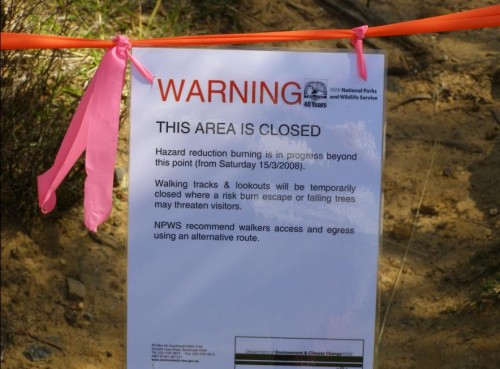 Wildlife Service ‘hazard reduction’ burn notice for Sublime Point escarpment at the end of Willoughby Road, Leura back on 15th March 2008.
(click photo to enlarge) Wildlife Service ‘hazard reduction’ burn notice for Sublime Point escarpment at the end of Willoughby Road, Leura back on 15th March 2008.
(click photo to enlarge)
.
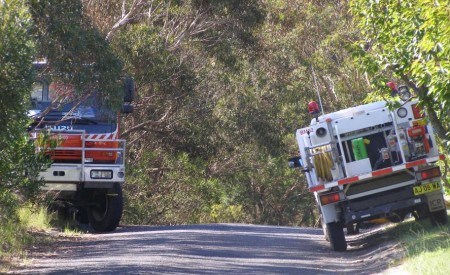 Warrimoo Rural Fire Service set up to conduct hazard reduction at Sublime Point, Leura (Carleton Road, Leura, 15th March 2008). Warrimoo Rural Fire Service set up to conduct hazard reduction at Sublime Point, Leura (Carleton Road, Leura, 15th March 2008).
.
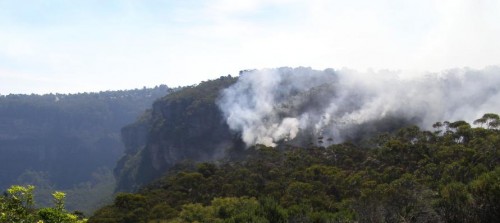
Rural Fire Service setting fire to escarpment vegetation at Sublime Point on the Jamison Escarpment, Leura. (Photo from Willoughby Road,Leura, 15th March 2008).
.
A year later again at Sublime Point…
.
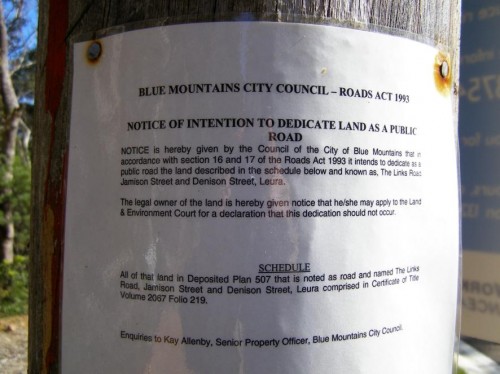 DECC Wildlife Service ‘hazard reduction’ burn notice for Sublime Point escarpment again on 24th March 2009, almost exactly a year to the date. DECC Wildlife Service ‘hazard reduction’ burn notice for Sublime Point escarpment again on 24th March 2009, almost exactly a year to the date.
.
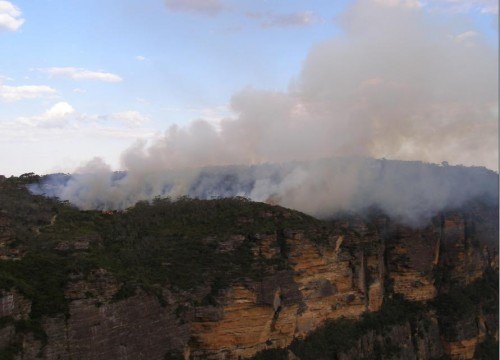 Blue Mountains Wildlife Service ‘hazard reduction’ burn of the Jamison Escarpment at Sublime Point 24th March 2009 Blue Mountains Wildlife Service ‘hazard reduction’ burn of the Jamison Escarpment at Sublime Point 24th March 2009
.
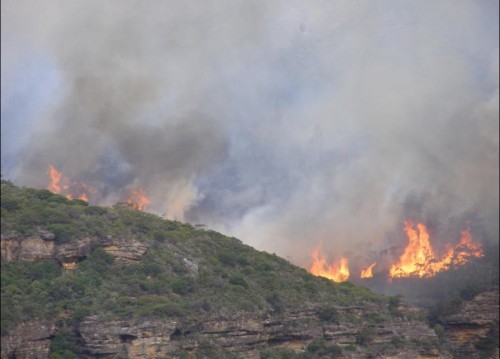 Blue Mountains Wildlife Service ‘hazard reduction’ burn of the Jamison Escarpment at Sublime Point 24th March 2009. Blue Mountains Wildlife Service ‘hazard reduction’ burn of the Jamison Escarpment at Sublime Point 24th March 2009.
.
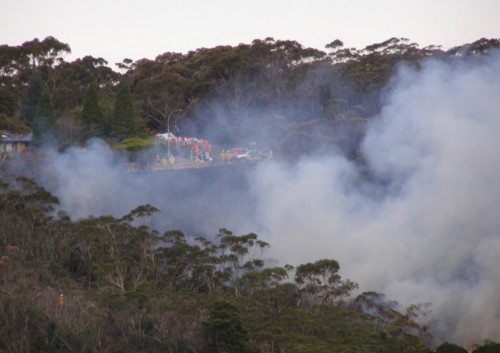 Fire-lighters watching on as their blaze gets out of control at Sublime Point 24th March 2009.
(Click photo for enlargement) Fire-lighters watching on as their blaze gets out of control at Sublime Point 24th March 2009.
(Click photo for enlargement)
.
.
 Same ‘hazard reduction’ burn out of control, requiring expensive and embarrassing helicopter water-bombing to stop the fire spread down into the protected Jamison Valley Same ‘hazard reduction’ burn out of control, requiring expensive and embarrassing helicopter water-bombing to stop the fire spread down into the protected Jamison Valley
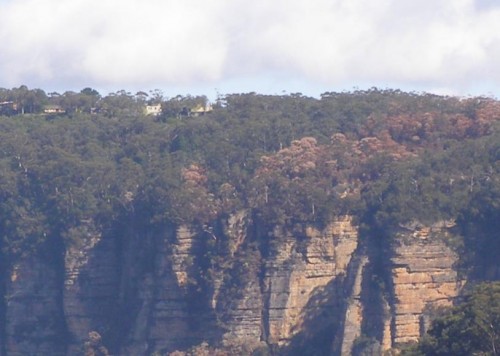 East side of Sublime Point (5th April 2009) showing burnt vegetation, where the HR burning had escaped and nearly entered down into the Jamison Valley.
(The media spin by bushfire management was that this section was arson, but not surprisingly the culprit was never found). East side of Sublime Point (5th April 2009) showing burnt vegetation, where the HR burning had escaped and nearly entered down into the Jamison Valley.
(The media spin by bushfire management was that this section was arson, but not surprisingly the culprit was never found).
.
nec.
Meanwhile, property developers at Sublime Point, a block away…
.

Leura’s recently approved and created ‘ The Links Road‘ (31st May 2008) following Council approved destruction of escarpment vegetation and subsequent subdivision ready for escarpment housing..with views.
.
Meanwhile, further along Cliff Drive at Katoomba…
.
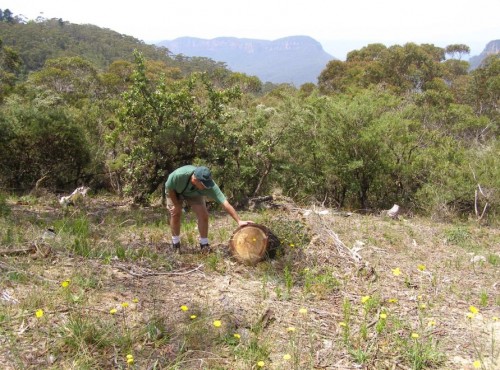 Editor inspecting native escarpment site on Cliff Drive, Katoomba back on 12th January 2008 that had been recently slashed by the Wildlife Service.
It just so happened that a house opposite on Cliff Drive was up for sale and would benefit from the fresh views of the Jamison Valley. Editor inspecting native escarpment site on Cliff Drive, Katoomba back on 12th January 2008 that had been recently slashed by the Wildlife Service.
It just so happened that a house opposite on Cliff Drive was up for sale and would benefit from the fresh views of the Jamison Valley.
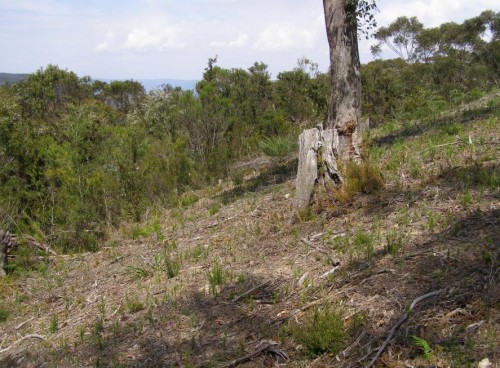 Same site, same date. Same site, same date.
.
 Seven months later, a few hundred metres west along Cliff Drive Katoomba,
some developer gets escarpment views towards Nellies Glen approved,
or is it more a case of ‘overlooked‘ by Blue Mountains (city)Council? Seven months later, a few hundred metres west along Cliff Drive Katoomba,
some developer gets escarpment views towards Nellies Glen approved,
or is it more a case of ‘overlooked‘ by Blue Mountains (city)Council?
.
.
.
-end of article –
Tags: Blue Mountains City Council, Blue Mountains western escarpment, Blue Mountains World Heritage Area, bushland housing, hazard reduction, housing encroachment, Jamison Valley, Katoomba, Leura, Links Road, NPWS, prescribed burning, Sublime Point, Wentworth Falls, Wildlife Service
Posted in Blue Mountains (AU), Threats from Bushfire, Threats from Development | No Comments »
Add this post to Del.icio.us - Digg
Monday, May 30th, 2011
 Land holders of Illford take a stand against the corporate mining threat
(Central Tablelands, New South Wales, Australia) Land holders of Illford take a stand against the corporate mining threat
(Central Tablelands, New South Wales, Australia)
(©Photo SMH, 20110530)
.
Illford rural landholder, Nell Schofield, has learned of deals by the New South Wales government and corporate miners to dig up rural land around her and the local community and bugger the environment in the process.
Greedy Sydney-based coal exporter Centennial Coal and Swiss-based coal-mining multinational Xtrata have secretly secured underground mining exploration licenses from the previous unscrupulous Labor Government of New South Wales in the rural Illford area, situated north-west of the Blue Mountains in the Central Tablelands of New South Wales.
In true Labor Party style, the big coal companies have strategically taken on a divide and conquer tactic over the local landholders to secure a legal foothold, by offering financially enticing agreements to individual land holders, slyly one by one.
”The way they come into the community is divide and conquer … they throw contracts down in front of landowners who don’t have lawyers. They just get done over“, says Schofield.
This reverberates of the similar scheming tactics employed by the NSW Roads and Transport Authority (RTA) across the nearby Blue Mountains. Under the past decade of NSW Labor Government direction, the RTA has village by village, bulldozed its juggernaut B-Double expressway through the Central Blue Mountain’s, urbanising villages into suburbs and dividing locals geographically in the process.
But these corporate miners will have a fight on their hands as their baby boomer boards pursue their 20th Century dirty energy agendas.
The locals of Illford and surrounding districts affected by this mining threat are set to follow the ame reaction by hundreds of Queensland farmers who have already vowed to lock their gates to keep coal and gas explorers at bay. They are also not alone – check the links below.
[Source: ‘Not in my backyard, actor tells coalminers’, by Cosima Marriner, The Sun-Herald, Sunday 29th May 29, 2011, http://www.smh.com.au/nsw/not-in-my-backyard-actor-tells-coalminers-20110528-1f9fr.html, viewed 20110529].
.
.
.
Find out about the Gas Industry Report in NSW 2009-10, click HERE
(Go to page 27, and be aware that from 1st March 2011, thanks to the previous NSW Labor Government, Origin Energy acquired the remaining dominant retail energy providers of New South Wales: Integral Energy and Country Energy).
.(Go
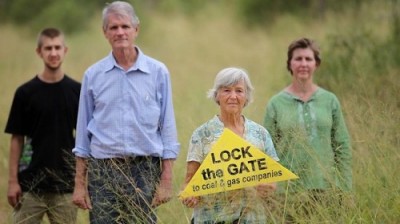 Drew Hutton and friends, the Greens
(Darling Downs, south-west Queensland)
(prepared to get arrested for campaigning against coal seam gas…and he did).
. Drew Hutton and friends, the Greens
(Darling Downs, south-west Queensland)
(prepared to get arrested for campaigning against coal seam gas…and he did).
.
Massive coal seam gas projects in the Darling Downs have received government approvals, but not community approval. The scam laws negotiated with the Queensland Government, under Section 804 of the Petroleum and Gas Act, permits mining and gas companies access to private land and provides for $50 000 fines for hindering the companies’ access.
This corporate intimidation of locals at its worst, and Origin Energy stands to be one of the largest investors, buyers and beneficiaries.
.
.
‘Origin Energy to invest additional $114 million in Queensland Coal Seam Gas’
(ASX/Media Release, 25th July 2006)
‘Australian integrated energy company Origin Energy will invest an additional $114 million in its Spring Gully Coal Seam Gas Project to double its production capacity to around 85TJ/Day thereby providing further security to Queensland’s energy supply. This investment will see Origin supply natural gas to prominent Queensland businesses QAL, Incitec Pivot and Energex.
.
Located 90km north of Roma in central Queensland, the original $200 million Spring Gully Gas Project entered into commercial service in July 2005 and has been performing above expectations by delivering higher than expected levels of natural gas. The Plant was officially opened in November 2005 by Premier Peter Beattie.
.
Origin Chief Operating Officer, Karen Moses, said the expansion of the Spring Gully Project further underpins and secures Coal Seam Gas as a reliable and key energy source for Queensland in the decades ahead. “There is a strong and ongoing role for Coal Seam Gas in the mix of Queensland’s energy supply,” said Ms Moses.
.
“Since Origin was listed in 2000 it has invested over $800 million in Queensland in oil and gas production, power generation and LPG distribution. Doubling the output of our Spring Gully Project maintains Origin’s position at the forefront of the gas industry in Queensland, as well as one the major providers of commercially proven Coal Seam Gas.”
.
“One of the most significant changes in Australia’s gas supply in recent years has been the emergence of Coal Seam Gas as a reliable and viable major new energy source for Queensland. We are particularly pleased that our Coal Seam Gas developments in Queensland are playing a crucial role in supporting the State Government’s Clean Energy Strategy* ”
.
“Origin is already committed to clean energy and, with over 100,000 customers, sells green power to more customers than any other energy retailer in Australia. Indeed, Origin has introduced GreenEarth Gas, the first product of its type in Australia to offset a customer’s greenhouse gas emissions from their use of natural gas” added Ms Moses.
.
Origin is also seeking Government approval for a nominal 1,000 MW gas fired power station to be co-located with the Spring Gully Gas Plant.’
.
[Source: http://www.originenergy.com.au/news/email-article/asxmedia-releases/682]
.
Live in NSW and concerned whether you’re at risk from mining leases under you?
.
Check this NSW Government Mining Lease map and make sure that you’re not in either of the two chlorine blue zones:
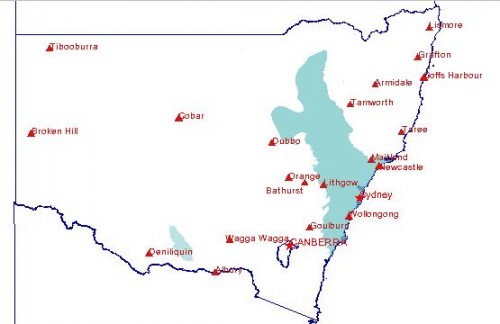 NSW State Mining Lease Map (‘TAS’)
NSW State Mining Lease Map (‘TAS’)
(Source: http://www.dpi.nsw.gov.au/minerals/titles/online-services/tasmap)
.
.
.
Further Information:
.
[1] ‘ Not in my backyard, actor tells coalminers‘, by Cosima Marriner, The Sun-Herald, Sunday 29th May 29, 2011, ^http://www.smh.com.au/nsw/not-in-my-backyard-actor-tells-coalminers-20110528-1f9fr.html
[2] Lock the Gate Alliance, Inc. ^http://lockthegate.org.au
.
[3] ‘ New Era for Mining Consultation in NSW‘, by Suzanne Hill, Thursday 14th April 2011, ABC Rural (NSW), ^http://www.abc.net.au/rural/nsw/content/2011/04/s3191549.htm?site=sydney
[4] ‘ New Mining Minister says reaching balance between mining and agriculture a challenge‘, by Suzanne Hill, Friday 15th April 2011, ^http://www.abc.net.au/rural/nsw/content/2011/04/s3192718.htm?site=sydney
[5] ‘ Anti-mining activists protest in Sydney‘, by Jessica Burke, 22nd March 2011, CoalMining.com.au, ^ http://www.miningcoal.com.au/news/anti-mining-activists-protest-in-sydney?utm_source=20110530&utm_medium=email&utm_campaign=newsletters
[6] ‘ The Impact of Coal Mining on the Gardens of Stone‘, by Keith Muir, March 2010, The Colong Foundation for Wilderness, ^http://www.colongwilderness.org.au/Gardens_of_Stone/Impact_of_coal_mining_on_GoS2_final_low_res.pdf
[7] (Various media releases on this issue), The Colong Foundation for Wilderness, ^ http://www.colongwilderness.org.au/media_releases/media_archive09.htm
[8] ‘ More on the death of Thirlmere Lakes‘, by Chris, 30th November 2010, Rivers SOS, ^http://riverssos.org.au/tag/colong-foundation-for-wilderness/
[9] Campaign against Mining & Gas, Nature Conservation Council (NCC), ^http://www.nccnsw.org.au/campaigns/mining-and-gas
[10] ‘ Open Cut Mine for Blackalls Park? – Where will you be when it all hits the fan? ‘, published in the interest of the community by webmaster: John Woods, ^http://www.anzacs.net/Awaba.htm (Lake Macquarie Electorate, NSW)
[11] ‘ Protest Centennial Coal AGM‘, Rising Tide Australia, ^http://www.risingtide.org.au/node/255 (Dated 2004, but organisation still very active)
[12] ‘ Charged Green won’t take foot off the gas‘, Daniel Hurst, 31st March 2011, Brisbane Times, ^http://www.brisbanetimes.com.au/environment/charged-green-wont-take-foot-off-the-gas-20110330-1cg57.html
[13] ‘ Farmers to ‘lock the gates’ on mining companies‘, Sunday 28th November 2010, by Jim McIlroy, ^http://www.greenleft.org.au/node/46263
[14] Environmental Defenders Office (EDO) on Mining, ^http://www.edo.org.au/edonsw/compliance/mining.html
.
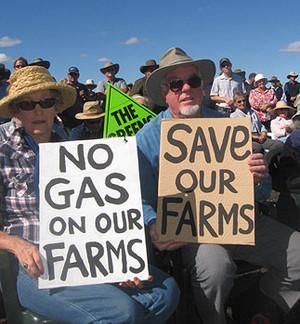 © Photo: Groomgreens.org © Photo: Groomgreens.org
.
.
-end of article –
Saturday, May 28th, 2011
Valuable fringe bushland of the Central Blue Mountains (BM) is steadily disappearing as a consequence of Blue Mountains (city) Council-approved housing development integrated with the associated hazard reduction burning that it invites.
Blue Mountains Council has become culturally conditioned to automatically squirm and acquiesce when any threat of a State Environmental Court appeal process that may be instigated to dare challenge Blue Mountains Council, despite a fair and rigorous environmental assessment and ruling. Local political pressure is such that now Blue Mountains Council staff are encouraged to give up and bend over, as if so urbane as to be beholden to developer intimidation. Yet for years such has become Blue Mountains Council’s urbane squeamish mindset, as if the staff and management came from overdeveloped Western Sydney (which most of them they have).
There are morally corrupt politics controlling land use development in the Blue Mountains ~ many are receiving a cut of perceived cheap, yet increasingly scarce, bushland habitat.
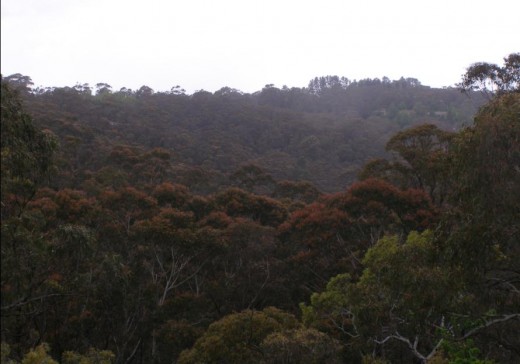 Thick natural bushland habitat just west of Katoomba
Central Blue Mountains Region.
New South Wales, eastern Australia. Thick natural bushland habitat just west of Katoomba
Central Blue Mountains Region.
New South Wales, eastern Australia.
.
.
Case in point:
.
Not so long ago, Blue Mountains Council approved this cypress pine cottage be built in/abutting thick timbered bushland on a west facing slope downwind of the prevaling westerly winds.
Bushfire risk mapping rated the site as ‘extreme’ bushfire risk, yet the cypress pine cottage got built. The builder/developer has long since profited and so moved on, leaving behind a bushfire vulnerable cottage on a site that should never have been built on in the first place.
But try telling a pro-development council that a property owner can’t develop his/her land!
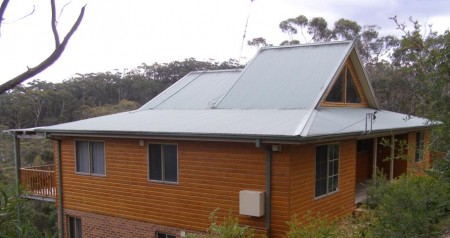 The cypress pine cottage, 2008
. The cypress pine cottage, 2008
.
The site was purchased in/abutting dense wooded bushland, which was slashed and bulldozed. Down from the house, around a dozen mature native trees were chainsawed to provide for escarpment views to the west.
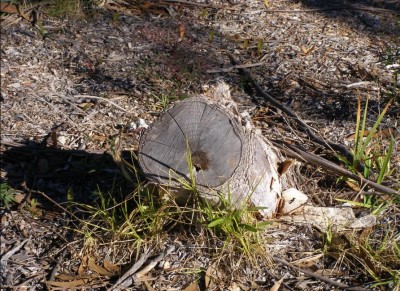 One of the chainsawed native trees
. One of the chainsawed native trees
.
The property has since been sold. Yet, the issue of a cypress clad cottage being approved in extreme fire risk bushland was raised with Blue Mountains Council’s senior development officer, Lee Morgan, on 25-Feb-2009 (Council ref. Customer Service Request #106889). But there was no response.
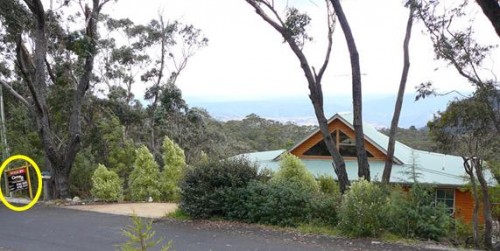 The cottage was sold in 2008…with views
…less the dozen chainsawed Eucalypts to make way for the views. The cottage was sold in 2008…with views
…less the dozen chainsawed Eucalypts to make way for the views.
.
It is typical of Blue Mountains Council’s planning approvals that they encourage development encroachment on the fringe bushland which separates the Blue Mountains National Park from the townships of the Central Blue Mountains.
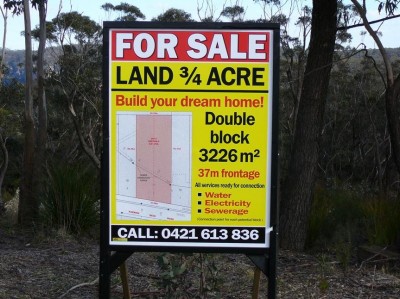
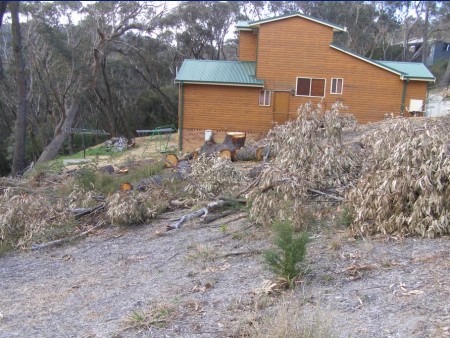 A nearby cottage of remarkably similar cypress pine cladding
has surrounding trees chainsawed and the vegetation slashed to bare earth. A nearby cottage of remarkably similar cypress pine cladding
has surrounding trees chainsawed and the vegetation slashed to bare earth.
.
.
Then comes the ‘hazard’ reduction
.
Housing development encroachment is being wedged deeper into fringe bushland, closer to the Blue Mountains National Park, many seeking the profit that escarpment views bring. The sites are indefensible against bushfire. Many are zoned extreme bushfire risk, yet these bush houses received Council building approval.
The Rural Fire Service (RFS) calls for hazard reduction because, with just its truck resources, it would not have access to defend these houses in the event of a serious bushfire. Co-incidentally, the property owners (developers) now cry for RFS hazard reduction to protect their ‘assets’ from the risk of bushfire. Co-incidentally, many property owners (developers) in the vicinity who have these new bush houses do the same.
Of course, to the fire-lighting cult, this is music to their ears and so the Rural Fire Service in cohorts with Blue Mountains Council rustled up a hazard reduction certificate. In September 2008, Blue Mountains Council’s Bushfire Technical Officer, Peter Belshaw, issued a Hazard Reduction Certificate for over 11 hectares of bushland and escarpment heath across Bonnie Doon Reserve to be burnt under a ‘hazard’ reduction programme. Click on image below for details.
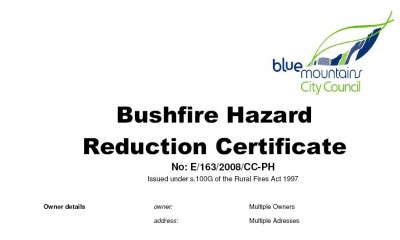 Click image to open PDF document Click image to open PDF document
.
Earlier that year in mid February (2008), some seven months prior, slashing of heathland and a watercourse had been carried out by a Rural Fire Service contractor in preparation for the hazard reduction burning ~ the fire-lighters just couldn’t wait.
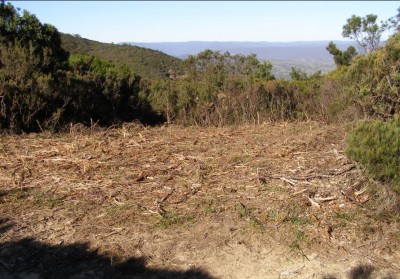 Blue Mountains escarpment is slashed by the RFS, a kilometre west of the cottage site. Blue Mountains escarpment is slashed by the RFS, a kilometre west of the cottage site.
.
.
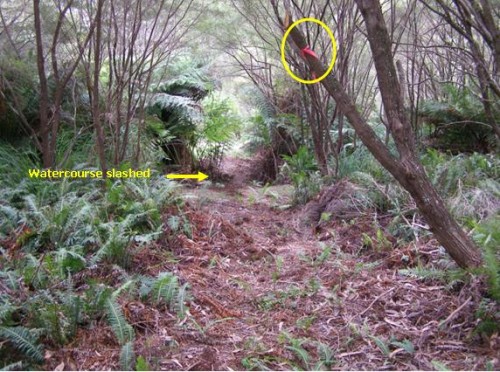 The RFS contractor slashed a trail for over 700m through heathland and through a riparian zone,
even before the Hazard Reduction Certificate was issued.
.
The RFS contractor slashed a trail for over 700m through heathland and through a riparian zone,
even before the Hazard Reduction Certificate was issued.
.
Then comes the intense HR burning:
.
Three years hence, mid afternoon on Friday 11th February 2011, smoke can be smelt and seen rising to the west on the horizon near Bonnie Doon Reserve. A call to emergency ‘000’ confirms that it is not a bushfire, but that official hazard reduction operations are underway. It is still well within the bushfire risk season.
.
Bonnie Doon Reserve is a natural wild area of about 22 hectares that includes a mix of bushland, heathland and upland swamp situated on the Blue Mountains escarpment at the western fringe of the township of Katoomba. It lies above Bonnie Doon Falls. The area is zoned ‘community land’ and ‘environmental protection’ and comes under the control and custodianship of the Blue Mountains Council. Bonnie Doon Reserve has a history of volunteer bushcare to conserve the still wild Blue Mountains escarpment habitat. The reserve is immediately upstream of the endangered Dwarf Mountain Pine (Microstrobos fitzgeraldii) and Leionema lachnaeoides (yellow flowering shrub) found almost nowhere else on the planet. The habitat conservation of both species, particularly the exclusion of fire are considered critical to their survival as a species.
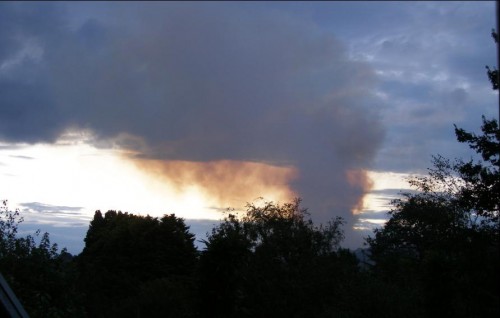 The ‘hazard’ reduction (HR) burning commences The ‘hazard’ reduction (HR) burning commences
.
From a distance of about two kilometres, I can see the smoke billowing strongly and its lasts for over two hours. The direction of the smoke places it around Bonnie Doon Reserve. The strength and density of the smoke indicates that it is more than light burning of ground cover. It is an intense but localised fire.
.
The aftermath of the burning:
.
We have our suspicions, but with other commitments we can’t get around there for some time to investigate the location affected to determine the scale and severity of the burning. In fact it isn’t until nearly three months later on Sunday 1st May 2011, that we inspect the burnt site. The fire was localised.
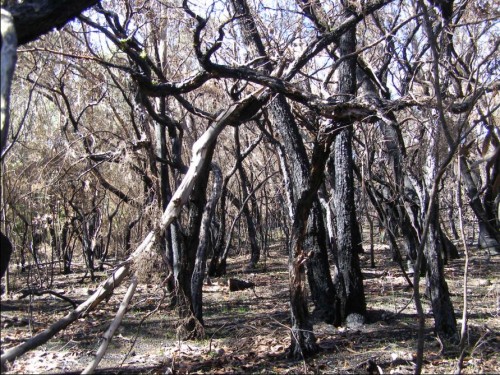 The aftermath
Three months on, evidence of more than just ground-cover has been burnt.
Deliberate intense burning has been allowed to penetrate deep into mature Eucalypts The aftermath
Three months on, evidence of more than just ground-cover has been burnt.
Deliberate intense burning has been allowed to penetrate deep into mature Eucalypts
.
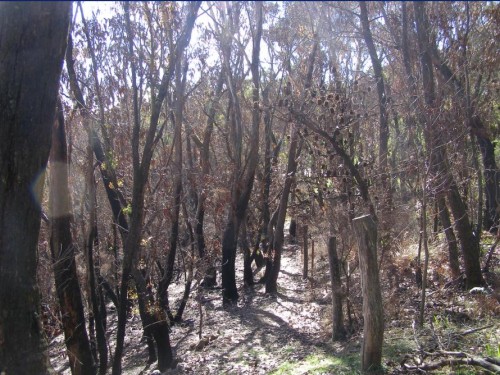
.
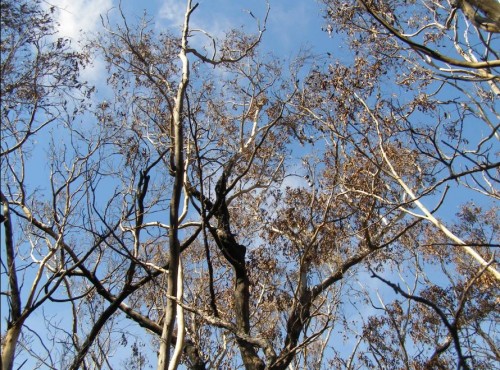 The fire was so intense that the flames reached into the tree canopy.
It must have been a blaze and half for RFS fire-lighters. The fire was so intense that the flames reached into the tree canopy.
It must have been a blaze and half for RFS fire-lighters.
.
.
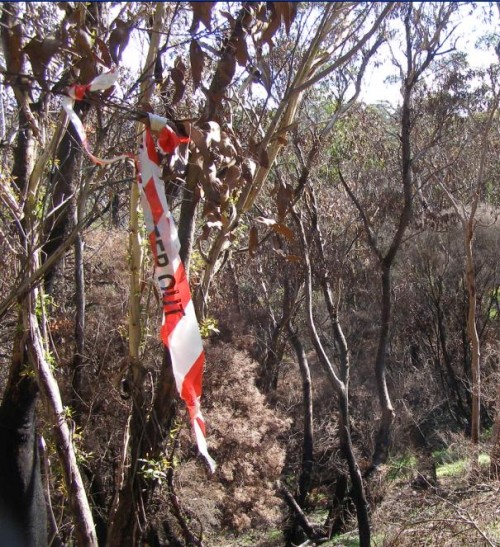 RFS telltale
. RFS telltale
.
The fire was indeed localised. It is very clear, still three months on, that this ‘hazard’ reduction burn had specifically targeted the native bushland surrounding the cypress cottage – an area of perhaps two hectares.
Consequence:
So not only has the developer of the cottage site completely destroyed the bushland on the site, but he has succeeded in having an additional two hectares burnt in the process all associated with the one cottage. Council’s initial approval of the cottage construction has directly led to the destruction of two hectares of what began as intact native bushland. The developer has profited from the bush, but in the process the ecological cost has been ignored ~ it is a perpetuation of a 19th and 20th Century single bottom line exploitation of the natural environment. It is happening across the Blue Mountains and being encouraged by Blue Mountains Council rules, practices and attitudes.
.
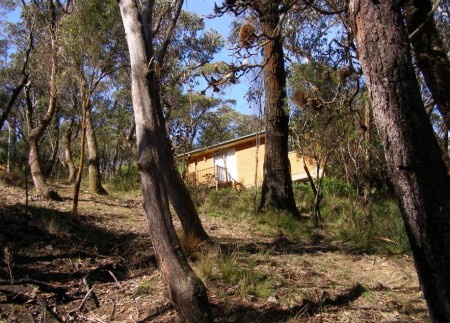 The cottage relative to the HR burn (aftermath) The cottage relative to the HR burn (aftermath)
.
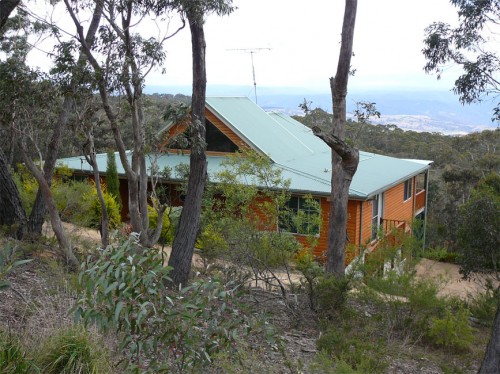
The cottage now with great views, plus an extra 2 hectares of cleared bush done cheap
Blue Mountains (city) Council making bushland-fringe development cheap
.
The ‘hazard’ reduction certificate process has become an insidious part of the development process across the Blue Mountains. The catalyst that is Council’s lax bushland protection zoning, is facilitating fringe deforestation. The combination of Council’s housing approvals on bush blocks with its ‘hazard’ reduction approvals have become a self-perpetuating twin mechanism for incremental encroachment into Blue Mountains fringe bushland, and it shows no sign of stopping.
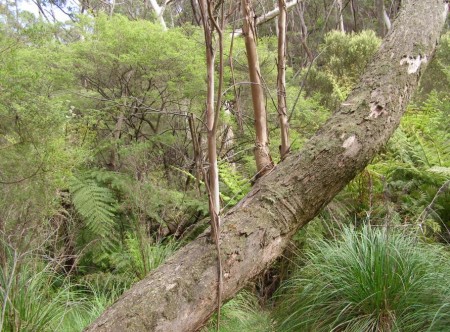 Bushland habitat at Bonnie Doon at risk of further burning Bushland habitat at Bonnie Doon at risk of further burning
.
Hazard reduction has become a cosy win-win-win-win outcome for all collaborators: (1) the builder/developer who profits, (2) the real-estate agent who get the sales commission (first when the bush block is sold, then again when the house is sold with views), (3) Council which earns developer charges in the short term and an expanded rate revenue base over the long-term, and (4) the RFS fire lighters who have become more adept and occupied lighting bushfires than putting them out.
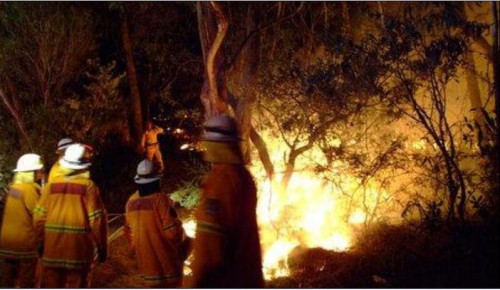 Fire-lighters look on during the Hazard Reduction Burn, Bonnie Doon Reserve Fire-lighters look on during the Hazard Reduction Burn, Bonnie Doon Reserve
.
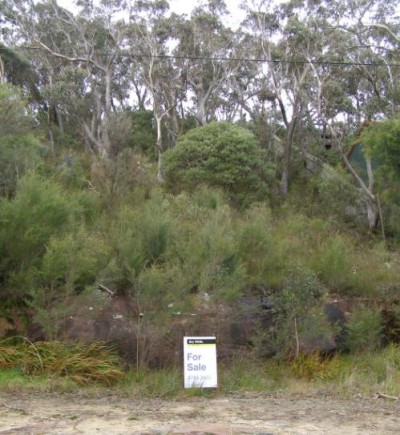 More bushland for sale
~ a ‘lose-lose’ outcome for native habitat and the remnant disappearing wildlife is supports.
More bushland for sale
~ a ‘lose-lose’ outcome for native habitat and the remnant disappearing wildlife is supports.
.
An harbinger of more burning for Bonnie Doon:
.
Of the eleven odd hectares of the 22 ha Bonnie Doon Reserve targeted by the RFS for slashing and burning on the hazard reduction certificate, nine hectares of bushland and escarpment heathland still stands to be burnt, which could happen anytime.
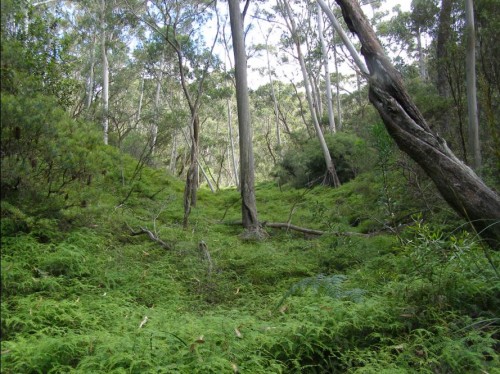 Bonnie Doon Reserve
on the western fringe of Katoomba township Bonnie Doon Reserve
on the western fringe of Katoomba township
(click photo to enlarge)
(Photo by us, so free in public domain)
.
– end of article –
.
 Blue Mountains escarpment is slashed a kilometre west of the house site Blue Mountains escarpment is slashed a kilometre west of the house site
, in preparation for over 11 hectares of buring Bonnie Doon Reserve
Tags: Blue Mountains City Council, Blue Mountains National Park, Blue Mountains World Heritage Area, Bonnie Doon Reserve, bush block for sale, bush fringe development, bush profits, bushland housing, Dwarf Mountain Pine, extreme bushfire risk, hazard reduction, hazard reduction certificate, housing encroachment, Leionema lachnaeoides, Microstrobos fitzgeraldii, property development, real estate land sales, Rural Fire Service, slashing
Posted in Blue Mountains (AU), Threats from Bushfire, Threats from Deforestation, Threats from Development | No Comments »
Add this post to Del.icio.us - Digg
|
|





































































